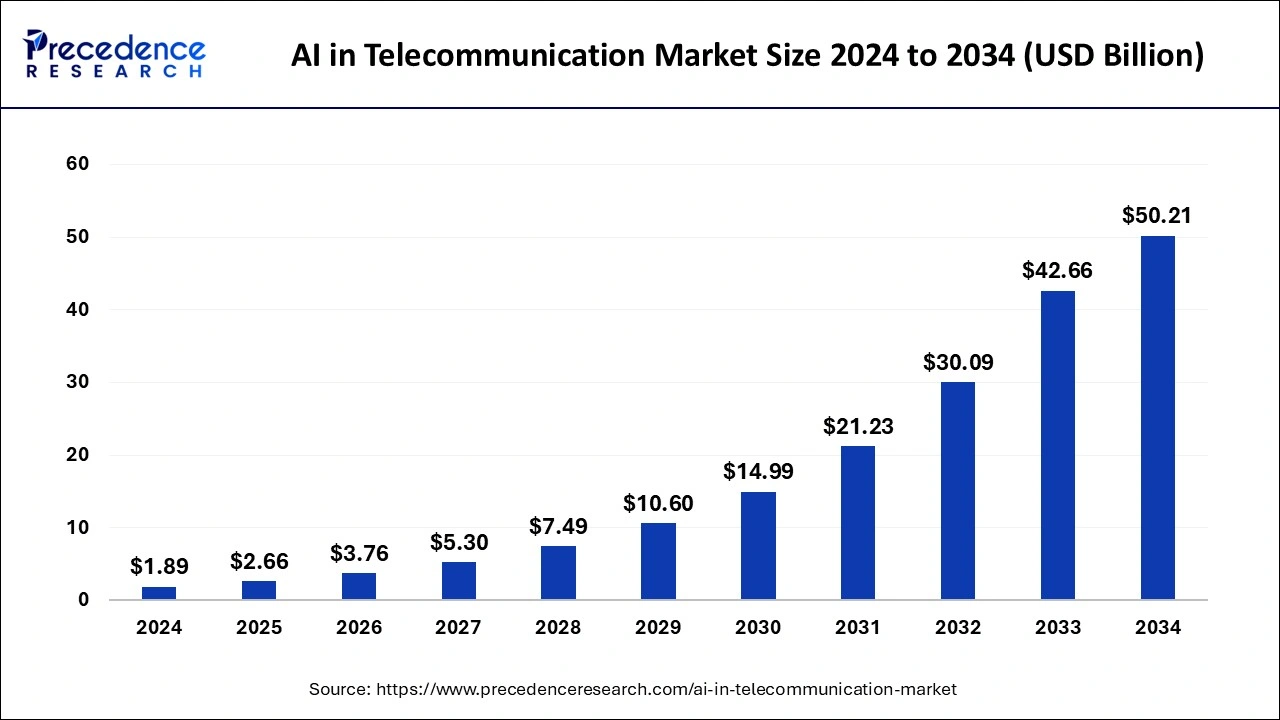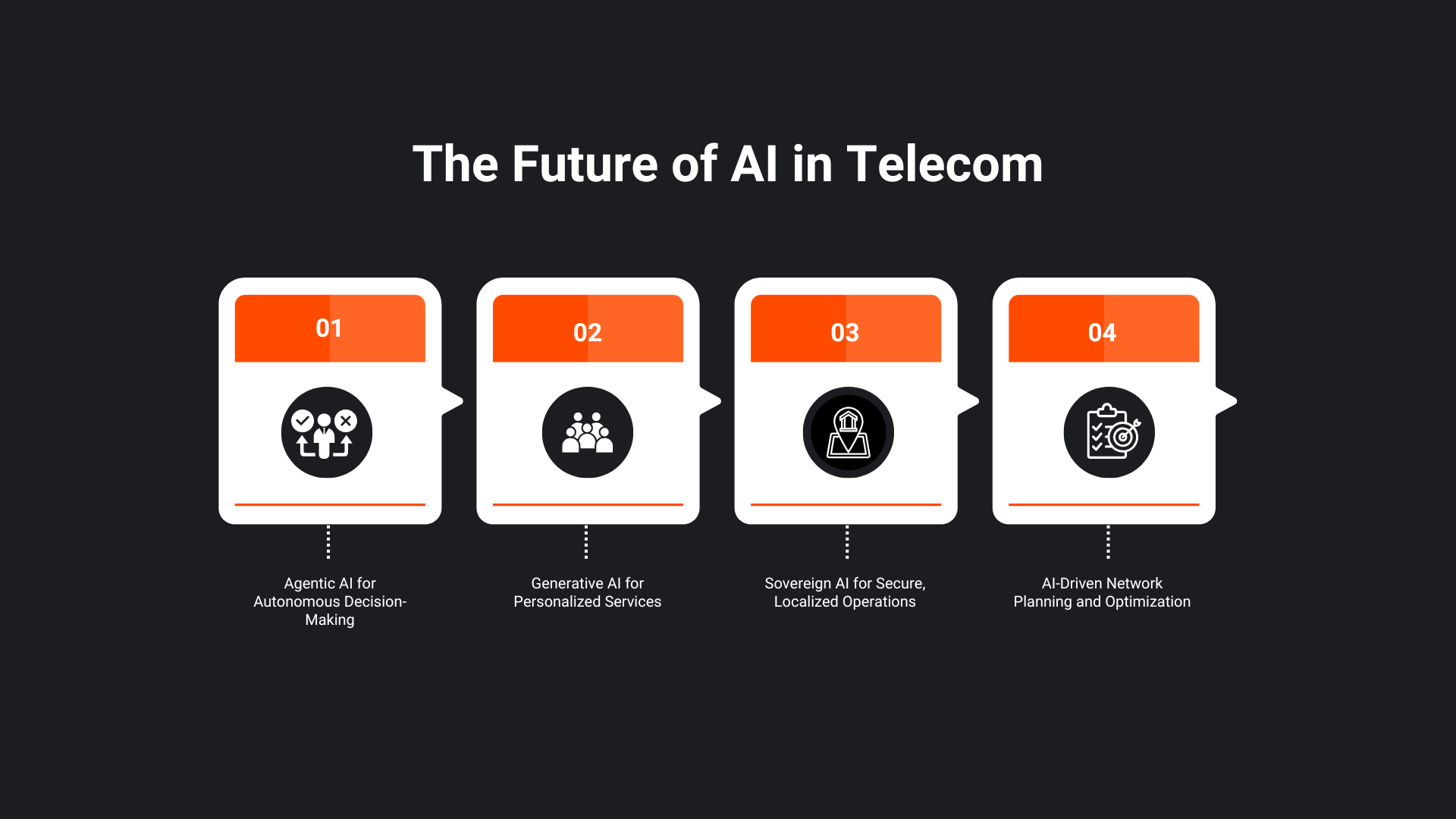How AI is Transforming the Telecom Industry
AI is changing how telecom companies operate, analyze data, and interact with customers. With AI development services, telecom operators can enhance their networks, improve service quality, and develop new solutions that meet customer demands and deliver clear business benefits.
.png?width=670&height=445&name=How%20AI%20is%20Transforming%20the%20Telecom%20Industry%20(1).png)
In the telecom sector, speed and accuracy are the real survival tools. Telecom operators consistently deal with increasing data traffic, high customer expectations, and very low profit margins.
That is why companies are investing in AI solutions for telecom to gain real advantages. They are automating network faults, responding instantly to customer issues, and extracting value from the large amounts of data created by 5G and IoT.
The global market for AI in telecom is growing quickly. It is expected to reach around USD 50.21 billion by 2034, with a growth rate of 38.81% each year from 2025 to 2034.

 Generate
Key Takeaways
Generating...
Generate
Key Takeaways
Generating...

-
Using AI in telecom offers many chances to improve customer service, streamline operations, and promote growth.
-
AI can analyze large amounts of customer data, helping telecom companies personalize their services and run targeted marketing campaigns. By understanding customer preferences, companies can improve their sales strategies and keep customers loyal.
-
Telecom companies can upgrade simple chatbots to more advanced AI assistants that can hold conversations like humans. This can make customer interactions more engaging.
-
AI technologies can also help with network optimization, predictive maintenance, and better resource management. This leads to more efficient network planning and operation, reducing downtime and enhancing the quality of service.
-
Generative AI solutions are helping telecom companies improve their operational effectiveness by enhancing customer service, network reliability, and process optimization.
Leading telecom companies are already using this technology. Vodafone's TOBi chatbot manages millions of customer chats without needing humans, significantly enhancing customer engagement. Verizon reports that its AI-driven service systems are increasing sales and providing faster solutions. This blog walks you through the use cases of AI for telecom operations.
What is AI in Telecommunications?
AI in telecommunications uses smart technology to enhance network performance, improve customer service, and increase efficiency in network operations. It analyzes large amounts of network data with machine learning and other AI models. This helps companies predict problems, optimize networks automatically, and provide personalized customer support. Artificial intelligence in the telecom industry can lower costs, prevent service outages, and meet growing data demands.
A new survey by the IBM Institute for Business Value found that many telecom leaders are already exploring and using AI in different areas of their businesses. In fact, according to a study by Nvidia, 97% of telecom companies are adopting AI. Of these, 48% are testing AI, and 41% are actively using it. Most telecom service providers believe that adopting AI and leveraging data science can give them a competitive edge. Therefore, the telecom industry should invest in the right AI technologies and services to maximize the benefits of AI.
Before deciding on the right AI technologies, let us take a dig into the top AI use cases in the telecom industry.
Transform your telecom operations Today.
Discover how AI can optimize networks, enhance customer experiences, and improve operational efficiency.
How AI is Transforming Telecom Industry?
Artificial intelligence in the telecom industry is being used in varied ways. It enhances customer experience, optimizes network performance, and boosts efficiency. Companies use AI-powered chatbots to provide faster customer service, predictive maintenance to avoid network outages, and data analytics to create personalized offers & manage networks in real time. Explore some of the top AI applications in telecom.
1. AI-Driven Customer Service in Telecom
AI chatbots in the telecom industry are enhancing customer connections. It allows for real-time problem-solving and personalized communication, with AI chatbots delivering accurate responses to customer inquiries, which improves customer satisfaction and operational efficiency. This results in shorter wait times and more automated support. AI chatbots and virtual assistants are available 24/7, cutting costs and increasing customer satisfaction. For major telecom companies, AI is vital for improving customer engagement and delivering swift, efficient solutions to improve customer satisfaction.
The future of AI in telecom is moving toward optimizing network performance through predictive analysis and proactive solutions. Artificial intelligence identifies network issues before they affect users. Advanced natural language processing and machine learning improve voice and text communication, leading to better customer support. Companies that invest in AI for telecom are seeing fewer customer defections, greater engagement, and optimized resource allocation.
2. Field Operations for Tech Rollout and Auto-Resolution
Many telecom providers have begun to automate network maintenance and send outage alerts to customers. However, some problems can be resolved with effective AI solutions, but still need a technician's help. Before sending a technician, companies should try to resolve issues on their own.
By automating routine operational activities, AI allows technicians and staff to focus on more complex and valuable tasks, increasing efficiency and providing a strategic advantage.
Technicians should have real-time updates to their daily schedules. A smart scheduling model can help prioritize tasks based on important factors like customer service agreements, equipment availability, task dependencies, traffic patterns, and network status. Telecom providers can use large language models (LLMs) from Generative AI to analyze past data and provide clear steps for resolving issues.
By evaluating customer behavior and resolution data, companies can better understand how specific problems and resolution times affect customer lifetime value (CLV). This information can help suggest personalized training and support for field agents, which can enhance customer satisfaction.
3. Enhanced Energy Efficiency
AI models can make smart decisions about how much energy the radio access network (RAN) uses and how to optimize resource allocation for radio resources. They can adjust these resources and turn off bands when necessary to save energy.
4. Fraud Detection & Security Enhancement
Digital payments and mobile banking are growing in India, but this has also led to a rise in telecom fraud, such as SIM card cloning and identity theft. AI-driven fraud detection systems help by:
-
Identifying unusual activities in real-time to stop SIM swap fraud.
-
Detecting strange data usage patterns to reduce cyber threats.
-
Improving KYC verification by combining AI with facial recognition and Aadhaar authentication.
For instance, AI-based fraud analytics at BSNL and Vodafone Idea have helped lower cases of cyber threats and financial fraud.
5. Sentiment Analysis
Social media shows public opinion, and telecom companies use AI sentiment analysis to understand it. By analyzing posts, they gain insights into customer thoughts, concerns, and trends. This helps resolve issues quickly through data science, improve brand image, and refine marketing strategies.
6. Network Planning and Design
AI models can help plan and implement cellular networks. They can assist with network mapping, create radio frequency (RF) maps, and support capacity planning. This helps network architects design more effective networks.
7. Fault Management and Anomaly Detection
Network operators use AI to find faults and problems in the network that can disrupt services, including network failures. When they detect unusual behavior, they can train models to help prevent similar issues in the future.
8. Predictive Maintenance in Telecom
AI algorithms evaluate equipment data to predict potential failures and maintenance requirements. This proactive approach minimizes downtime, prevents service interruptions, and enhances operational efficiency while optimizing maintenance schedules.
9. Agentic AI in Telecommunications
Agentic AI improves technology by using several tools. It uses generative AI for talking to customers, machine learning (ML) to study data and patterns, and reinforcement techniques to help AI agents learn from their actions. The industry aims to create interactions with customers that feel almost human.
Lead the AI-driven telecom revolution
Automate operations, personalize customer interactions, and gain a competitive edge with advanced AI solutions.
Overcoming the Challenges in AI Implementation in Telecom
While AI has great potential, telecom companies face challenges when implementing it. Here are some important things to consider:

1. Data Privacy and Security
AI uses a lot of customer data, which raises concerns about privacy and security. It is important to protect customer data properly, implement security measures, and follow the rules.
AI models need high-quality and diverse data to provide accurate insights. Telecom companies might face challenges like data silos, incomplete information, and existing data from various sources. These issues can impact how well AI algorithms work and may lead to unreliable predictions.
2. Integration with Existing Infrastructure
Integrating AI systems into the current telecom infrastructure can be complex and time-consuming. Telecom companies need to ensure their existing systems can work with AI technology and that data can be combined easily without disrupting everyday operations. This often means spending a lot on upgrading infrastructure.
Companies also need to manage costs and resources carefully. They must weigh the possible benefits against the expenses in the telecommunications industry and allocate their resources wisely to reduce operational costs and make sure the implementation is successful.
3. Workforce Transformation
As AI systems start to take on more tasks, employees will need training on how to work alongside these systems and use their features effectively. This will also involve teaching employees new skills to adapt to updated technologies and processes.
Telecom firms should invest in training programs to help their employees gain the skills required to work with AI. This investment in intelligent automation will boost employee productivity and help them stay relevant in a changing industry.
4. AI Fraud Detection in Telecom
Fraud costs telecom companies millions of dollars each year. AI helps find suspicious activities in real-time, like unusual call patterns, SIM swaps, or account problems. By detecting threats early, companies can stop revenue loss, protect customer trust, and lower the costs of manual fraud monitoring.
5. Network Automation Using AI
Managing complex networks manually is slow and error-prone. With AI-driven network automation, telecom operators can automatically set up, monitor, and improve their networks. This helps reduce downtime, speeds up problem-solving, and gives customers faster and more reliable service. It also lowers operating costs.
6. AI in Telecom Analytics
Telecom companies generate massive amounts of data every second. AI analytics turns this data into actionable insights through advanced analytics: predicting network congestion, identifying profitable customer segments, and optimizing service offerings. Business leaders can use these insights to make smarter decisions, increase efficiency, and drive revenue growth.
7. Intelligent Network Management
Advanced AI systems help networks operate independently. Smart network infrastructure management checks performance, predicts problems, and adjusts itself to keep service high-quality. For executives, this means fewer outages, better use of resources, improved network efficiency, and a stronger ability to provide seamless connectivity to customers.
Transform your telecom operations with AI-powered insights
Invest in AI development services to enhance service quality, predict maintenance needs, and gain a competitive edge.
The Future of AI in Telecom
As we look ahead, AI is set to change the telecom industry with new solutions that improve efficiency, enhance customer experiences, and create new ways to earn money. Here is what you can expect:

1. Agentic AI for Autonomous Decision-Making
Rather than just providing valuable insights, AI is moving forward to making decisions. Now, some AI systems can manage network operations on their own. They can find and fix problems in real-time and optimize resources without needing human help. This change allows for quicker responses and stronger networks.
2. Generative AI for Personalized Services
Generative AI will change how companies interact with customers by providing personalized content, responses, and recommendations. In the telecom industry, this means more customized support, flexible pricing options, and content delivery that matches each person's preferences. The generative AI market in telecom is expected to grow to $29 billion by 2034.
3. Sovereign AI for Secure, Localized Operations
Telecom companies are starting to use "Sovereign AI" with the arrival of 6G. This means they are creating and controlling AI systems locally. By implementing AI governance, they can protect sensitive data and follow laws specific to their country. This approach helps maintain control over data and ensures security.
4. AI-Driven Network Planning and Optimization
AI is improving how companies plan their network operations using tools like TelePlanNet. This system uses advanced technology to help choose the best locations for cell towers. As a result, network coverage improves, costs go down, and customers are happier.
These improvements are essential for telecom leaders to gain a competitive edge in a digital world. Adopting these AI-driven solutions is essential for creating new opportunities and providing great value to customers.
Deliver faster & smarter customer experiences
Explore AI solutions that improve engagement, streamline operations, and boost satisfaction.
Bottom Line
AI is changing the telecom industry by improving networks, customer experiences, and efficiency. Telecom companies using AI can predict maintenance needs, manage networks better, analyze data, and offer personalized services. This gives them a competitive advantage.
By investing in AI development services, telecom operators can lower costs, enhance service reliability, and create new offerings that meet changing customer needs. Get in touch to see how AI can help in your specific telecom business case.
Frequently Asked Questions
Have a question in mind? We are here to answer. If you don’t see your question here, drop us a line at our contact page.
How does AI affect the telecom sector?
![]()
AI is changing the telecom industry by automating network operations and improving service quality. It helps service providers predict problems, manage large amounts of 5G data, and deliver personalized services effectively. This approach cuts costs and reduces downtime while enhancing performance.
What is a good use case for AI?
![]()
A strong use case of AI for telecom service providers is one that provides clear benefits. In the telecom industry, key examples include predicting when network maintenance is needed, using AI chatbots for customer support, detecting fraud, optimizing network efficiency, and making personalized recommendations. These applications help improve efficiency and increase customer satisfaction.
What is a generative AI application in the telecom industry?
![]()
Generative AI helps telecommunications companies create realistic synthetic data, power advanced chatbots, generate reports, and simulate network events. This technology improves automation and encourages innovation in operations, customer care, and network planning.
What is predictive maintenance in the telecom industry?
![]()
Predictive maintenance uses AI tools to monitor network equipment and detect problems. It predicts failures before they happen. This helps reduce downtime, increase the life of equipment, and provide consistent service.
How is AI used in customer experience?
![]()
AI improves the customer experience in telecom by using virtual assistants, making service recommendations based on predictions, and resolving issues in real time. AI-driven customer experience offers proactive support, understands customer behavior, personalizes interactions, and speeds up problem-solving. These changes help increase customer satisfaction and provide a more personalized service.
How is AI used in Telecom?
![]()
AI helps improve many areas in telecom, including network management, automation, customer service, fraud detection, and predictive analytics. Telecommunications providers use AI for network modernization to make their business operations smoother, increase reliability, and provide better digital experiences for their customers.



.png?width=344&height=101&name=Mask%20group%20(5).png)
















